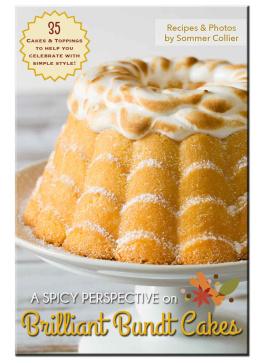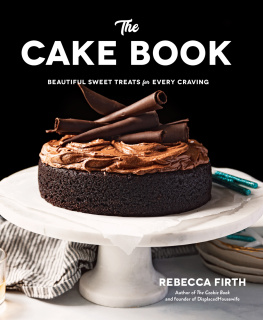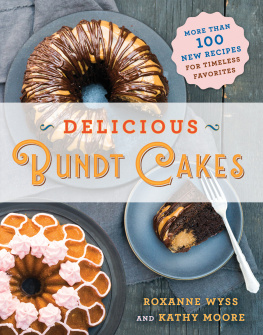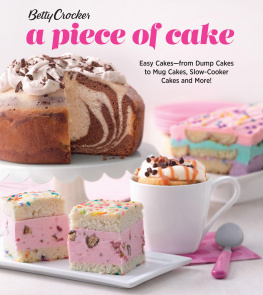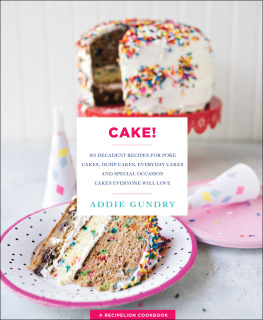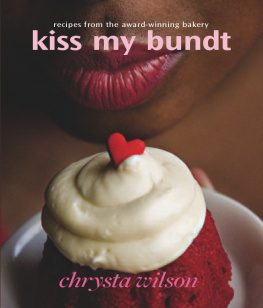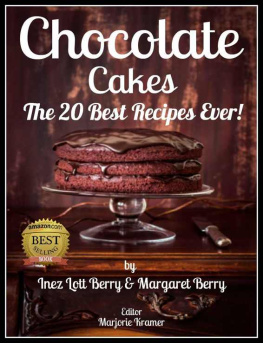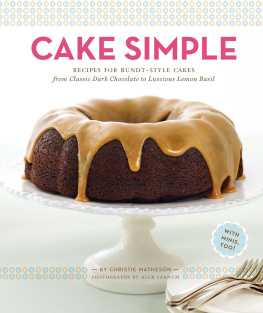


Brilliant no-fuss bundt cakes that taste like a dream.
Brilliant Bundt Cakes
Copyright 2014Recipes & Photos by Sommer Collier Of ASpicyPerspective.com
The content in this ebook is for Personal use only.Content may not be replicated or sold. For information on how to become an Ebook affiliate, link to ASpicyPerspective.com .
Why Bundt Cakes?
Bundt cakes are the girl next door in the world of cake.
They are naturally pretty with very little effort, due to their shape. They are simple and sturdy (making them easy to transport to parties and picnics) yet offer some of the best flavors and textures of any cake youll ever try. They are quick to prep and uncomplicated to decorate, due to the lack of frosting.
Bundt cakes make both the baker and the partaker supremely happy. Easy to make and easy to enjoy... thats why we love them!

Where there is cake there is hope... and there is always cake around somewhere. - Dean Koontz
Special Thanks
OK, so this is only an ebook, but I still have some people to thank. Being thankful is highly important...
Id like to thank God who gives me peace when life gets crazy and self-control when Im surrounded by bundt cakes.
Id like to thank my family for putting up with me even when I served bundt cake for dinner (for weeks) and for overlooking the eternal sprinkling of flour on the floor.
Id like to thank all my buddies in the blogging community who offered support through my ebook producing process. You guys are the best!
Contents
Keep Calm and Bundt On.

Thoughts on Baking
I used to tell my cooking class students that cooking is art and baking is chemistry , generally speaking.
In cooking, you can throw in a handful of herbs or a little more butter, like you were adding a bit more burnt sienna to an oil-painting. You can make changes as you go with no major catastrophe in the end.
In baking, everything matters . One small adjustment could be your undoing, but you won't know it until you pull your cake out of the oven.
This is not meant to discourage you from baking. It's meant to encourage you to learn a little more about the science of baking so that you can get the result you want more often, and understand a problem, if one occurs.
Elements That Affect Baking:
When making something for the first time, read the recipe thoroughly before you start. Follow every step to a tee. Remember, the recipe developer thought each element was important enough to document, so there must be a reason for it.
Temperature Matters. If a recipe calls for cold butter, melted butter, or room-temperature eggs, remember that any adjustment will effect the outcome. The difference between putting a dough with cold butter and one with warm melted butter, in the oven, is HUGE. It results in a completely different chemical reaction. Take the time to set your dairy and eggs out ahead, if they need to be room temperature.
Measuring Matters. We Americans like to kick it old-school in the measuring department, relying on cups and spoons to give the proper proportions. Yet pastry chefs worldwide measure their ingredients by weight. The reason for this is that a cup of flour can vary greatly in weight depending on the type of flour, and how packed it is.
In a perfect world all home-cooks would use scales and metric measurements to insure exact amounts of wet and dry ingredients. As that's never going to happen, make sure to always pour ingredients into your measuring cups, never scoop. Scooping packs the ingredient down, meaning you end up with more than you want. Always level the measuring spoons and cups with a knife or spatula.
Ingredients Matter. Different brands of butter, yogurt, buttermilk and flour have varying levels of moisture, fat, and protein. These little variations can greatly effect the outcome of the final product. Use the brands the recipe developer recommends, or find brands that suit your baking needs.
Freshness Matters. Butter loses moisture the longer it sits in the fridge. Baking powder, baking soda and yeast lose their lifting power over time. Make sure to shop often and store well.
Mood Matters. This may sound silly, but it has to do with measuring and delicacy. A pastry chef once told me that when she's upset, her recipes don't turn out. She's heavy-handed while measuring and rough on the dough and batter. She is physically not in the proper state of mind to turn out a perfect baked good. Try to bake when you are relaxed and have plenty of time.
Weather Matters. Standard "room temperature" is right around 70 degrees. If you bake when it's really hot outside or bitter cold, and the outside temperature is affecting the inside temperature, your results will be different. If the humidity is higher or lower than normal, your results will be different. That's why grandmas use to say never bake on a rainy day. The heavy moisture in the air effects the ability of the dough/batter to rise and dry.
I wish I could tell you to only bake when all the stars align. Then your baked goods would come out the same every time.
But that's not life.
We bake on rainy days because we're stuck in the house. We bake on days we are feeling blue, because it lifts our spirits. We bake in a hurry to finish dessert before our guests arrive.
Just try to remember, EVERY element effects the outcome. Your muffins may be dome-topped one day and flat the next. Your cake may be ultra moist one day and light and dry the next. It all depends on the conditions.
Simply do your best to make the conditions as "optimal" as possible.
Basic Bundt Cake Tips
Bundt cakes are a different breed of animal than classic sheet cakes or layer cakes. You cant expect to pour a classic cake batter into a bundt pan, bake a little longer than normal, and end up with perfection. Bundt cake batters are dense and heavy, so they can bake into ultra moist rings that hold up during transportation.
However, bundt cakes can be very easy to make, maybe thats why we love them so much. Yet there are a few things to consider that will help you have successful bundt cake baking endeavors. Here are my most important bundt tips.
Bundt Cake Tips:
Grease and Flour. Bundt cake pans should always be thoroughly greased and floured, so the bundt cake can slip out of the pan easily after cooling. The more grooves your bundt cake pan has, the more you need to pay attention during the greasing and flouring process. I like to use a baking spray like Pam or Bakers Joy that incorporates flour in the spray. I feel like I get better coverage with a spray, and the fact that its a one-step process is nice. Hold the bundt pan over the sink (to reduce clean up) and spray every nook and cranny of the bundt pan. Then if you feel your bundt batter is particularly sticky (like one that contains toffee, caramel chips, or fresh fruit) flour the bottom a little more. You can certainly use the old-school method of rubbing the bundt pan with butter or shortening then tossing flour in it to coat the sides, but this takes a bit more time.
Next page
